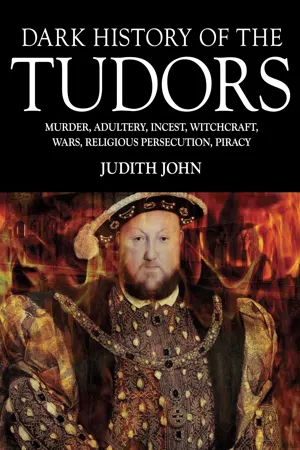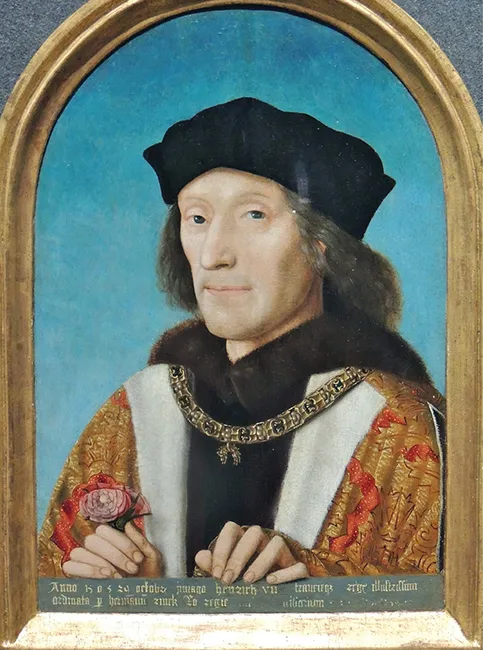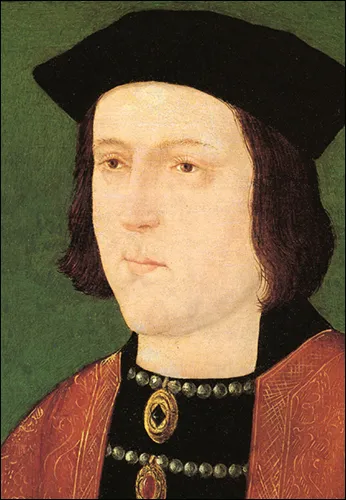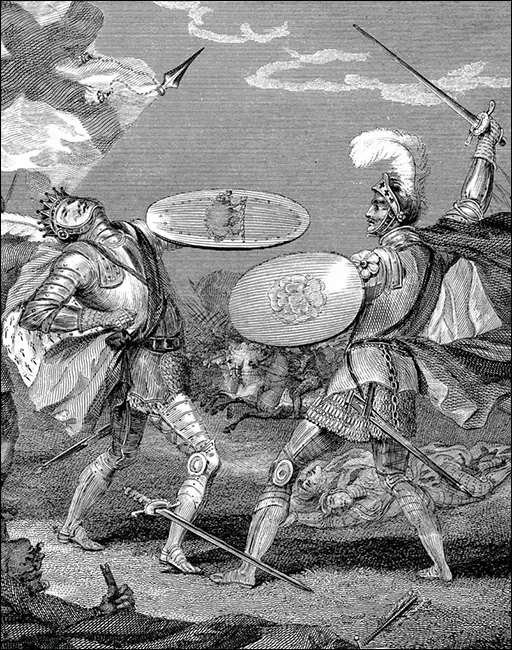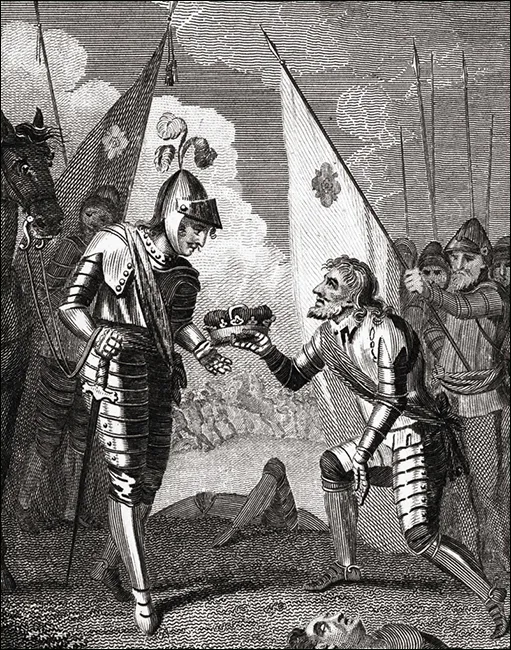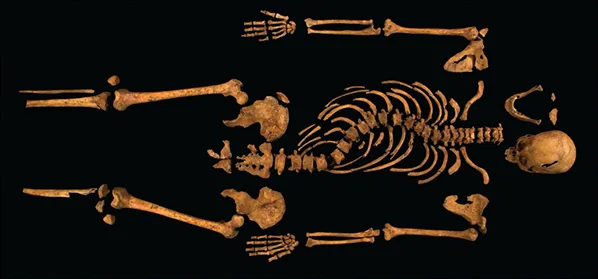![]()
This picture shows King Henry VII, lavishly robed and holding a Tudor rose. Note the combination of the white rose of York and the red rose of Lancaster, united under the Tudor King.
I
TUDORS
HENRY VII:
ORIGINS OF A DYNASTY
The Tudor era lasted from 1485 to 1603. Compared to the House of Plantagenet (1154 to 1485), this was not long, yet the Tudor period is packed with some of the most famous and infamous British monarchs. Their legacy lives on in many dark and disreputable stories, including murder, execution, treason, false imprisonment, womanizing, illegitimate children, religious turmoil and the burning of heretics.
The turbulent reign of the first Tudor King, Henry VII, begins.
Henry VII’s ascent to the throne in 1485 was by no means secure. At the time of his coronation there were more than ten others with a greater claim than him, including his own mother, Margaret Beaufort. A direct descendant of John of Gaunt, Margaret was his great-granddaughter. However, a combination of circumstances, political manipulation and personal belief in himself as the rightful King would mean that Henry of Richmond would become Henry VII, the first Tudor King, who successfully ended the War of the Roses and united the houses of York and Lancaster. But his reign, and that of his ancestors, was by no means peaceful. Henry would live in constant fear of someone coming along to usurp his hard-won crown.
Edward IV’s portrait shows a healthy, happy man. Yet Edward died suddenly at the age of forty-one of an unconfirmed illness. Many believe his appetites and excesses in life led to his untimely death, which triggered a resurgence in the fight for the crown.
Growing Up in Exile
As Henry was a potential rival to the Yorkist monarchy – first to Edward IV, then Richard III – he was sent away from home for his own safety as a child. By the time Henry reached the age of 14 in 1471, his father, the weak-willed Edmund Tudor, had died and the continuing Wars of the Roses made life in Britain too dangerous for a potential claimant to the English throne, so Henry was taken to Brittany by his mother and uncle, Jasper Tudor. Brittany was a separate, independent duchy, governed by Francis II and was at that time not considered part of France (even though the current French King, Louis XI, desperately wanted to claim it as part of his kingdom). This meant that Henry was relatively safe from attempts by both Edward IV, then Richard III, to coax Louis XI into sending Henry back to England, where it was likely that the threat he presented to the King would have resulted in his imprisonment or even execution.
During his time in exile, Henry grew up to be well versed in the ways of court and a noble life. As well as providing more traditional learning, his education would have included being able to ride, dance and pay a glowing compliment to the ladies of the court. However, alongside these frivolities lurked the continuous threat that he, Margaret and Jasper might be forcibly returned to Britain.
Henry’s long exile in Brittany did not end until 1485, when he chose to return to Britain with the aim of seizing the crown from Richard. Throughout his exile, both Edward and Richard had tried many times to rid themselves of the growing threat that Henry presented. It was the events in England that followed Edward IV’s death in 1483, then Richard’s usurpation of the crown from his nephew, Edward V, that same year, which led to Henry’s decision to seize control himself, which was both bold and foolhardy – a decision that would shape Britain’s monarchy, political structure and religion for more than a century.
THE TOWER OF LONDON
TODAY A POPULAR tourist attraction that houses the Crown Jewels, the Tower of London remains as a dark reminder of England’s bloody past. Work on the Tower begun under William the Conqueror in the eleventh century, originally as a palace.
However, the Tower is most notorious for its use as a prison from the fourteenth century. It was here that any pretenders or challengers to the throne, plus anyone guilty of treason and awaiting execution, would be taken, occasionally to disappear forever (see the Princes in the Tower feature). During its long existence, the Tower has also been used as a fortress, armoury, treasury and a home for the Royal Menagerie.
The magnificent Tower of London still stands as a memory of England’s bloody past. The fortress consists of several towers, including the Wakefield Tower, where mad Henry VI died in 1471.
His lunacy exacerbated by the stormy events of the past few years, Henry VI was captured during the Battle of Northampton in 1460. Due in part to Edmund Grey’s treachery in refusing to fight against the Yorkists, the Lancastrians suffered a crushing defeat.
Reclaiming the Kingdom
A previous attempt in 1484 to snatch the crown from Richard, aided by the Duke of Buckingham (who had transferred his support from Richard to Henry), had been unsuccessful. Henry and his allies tried to land at Dorset but found Richard’s troops waiting to strike. Henry returned to Brittany and Buckingham was executed while trying to escape to Wales. However, Henry would soon need to make another move. He now had the increased support of other influential Lancastrian and Yorkist exiles, including his ever-faithful uncle, Jasper Tudor. Jasper ensured that Henry was kept safe throughout negotiations between Richard and Francis II, the Duke of Brittany. Francis initially harboured and supported Henry – despite Edward IV trying to get his hands on the boy – but he was not to be trusted and had secretly begun to negotiate with Richard ever since Louis XI’s death in 1483. Henry and his exiles found out about this treachery and fled to France, where Charles VIII, the new young French King, gave them sanctuary but offered little practical support to Henry in his claim to the throne.
JASPER TUDOR
RELATIVELY LITTLE IS known about Henry’s uncle, his father’s brother, apart from the fact that he was one of Henry’s greatest and most trusted advisors. Joining his nephew and sister-in-law in their exile, Jasper worked alongside Margaret Beaufort to promote Henry’s claim and joined him in the decisive Battle of Bosworth. Jasper’s allegiance came in part from his undying affection for his half-brother Henry VI, who had awarded him titles despite the dubious legitimacy of his parents’ secret marriage. Jasper was also a skilled military man, his knowledge of battle tactics being put to good use at Bosworth Field. His reward was to be granted the title of Duke of Bedford in 1485, making him one of the only members of Henry’s council to be of noble birth, in addition to Margaret Beaufort and John de Vere.
Jasper Tudor (right panel) as depicted on a church stained glass window.
FACT OR FICTION: Y MAB DAROGAN?
A HUGELY INFLUENTIAL factor in Henry’s Welsh support were the claims – highly exaggerated and played upon by Henry – that he was Mab Darogan, or the Son of Destiny.
Mab Darogan was a mythical figure in Welsh folklore who dates back to the time of King Arthur. It was told that Mab Darogan would claim Britain back from the Anglo-Saxons, returning power to the Celts.
Henry’s march through Wales and defeat of Richard certainly added flesh to the legend, and was a factor in both his victory and subsequent relations with Wales.
The uncertainty of Henry’s position, plus his growing support from men in France, England and Wales, meant that the time had come for him to make another attempt to appropriate the English throne.
In addition to his ever-growing support, Henry had a stroke of good fortune when Richard III’s only son and heir, Edward, died in 1484. His death left the path to the throne clear for Henry to take it for himself, casting off the Yorkist King once and for all.
Making His Move
Henry’s decision to invade England via Wales was inspired; Henry’s Welsh background meant that he could be sure of the support of several powerful Welshmen, including Rhys ap Thomas, an influential landowner and soldier who promised troops to Henry.
This time, Henry and his army sailed to Milford Haven, on the southwest coast of Wales. Landing in Wales to gather support enabled him to boost his meager force of around 2500 men – made up of mercenaries and around 500 English exiles – giving him extra men to lead into battle against the might of Richard’s superior forces. Despite being at a disadvantage, the second attempt proved much more successful, as Henry marched through Pembrokeshire to Shrewsbury, then on into the English Midlands. Richard, who had underestimated his own unpopularity and assumed that Henry’s army would be opposed en route, was not as prepared as he should have been for a war on his own turf. However, his hastily gathered troops still far outnumbered Henry’s army. He was aided in his war plans by John de Vere, the Earl of Oxford, who had deserted the Yorkists to lend his support to Henry and who would remain loyal to Henry throughout his reign.
DEEDS OF POWER: THE WELSH CONNECTION
HENRY OFTEN PLAYED upon his Welsh background when it suited him. He was born in Pembroke Castle in Wales, where he lived for the first four years of his life until he was taken to Brittany for his own safety. He named his first-born son Arthur, harking back to the Arthurian legends still strong in Wales.
He also made Arthur Prince of Wales in 1489, which did much to keep Welsh support, and celebrated St David’s Day on 1 March. Henry also kept up Welsh support during his reign by issuing charters giving certain Welsh communities the rights of freeborn Englishmen.
Of course, he made sure that he was well paid for any privileges he needed to award. Despite his championing of the Welsh when it suited him, Henry was actually only one-quarter Welsh. He never lived in Wales after his coronation and did not speak the language.
This illustration shows the imagined moment of Richard III’s defeat at the hands of Henry VII at Bosworth Field, even though it is uncertain who actually dealt the blow that killed Richard. The new king is majestic and brave in this potent piece of propaganda.
After Richard III was struck down, his crown was retrieved and presented to Henry VII on the battlefield. This illustration shows Henry’s men eagerly watching as they proudly hold Henry’s standards aloft, surrounded by remains of the Yorkist troops.
FACT OR FICTION: RICHARD’S REMAINS
AFTER THE BODY of Richard III was cut down from its gory display in Leicester – Henry wanted proof of his victory on display for all to see – he was buried in Grey Friars church in 1485, with Henry himself paying to have a monument erected. His body had at least ten stab wounds and it is not known who actually dealt the killing blow, although some bestow this honour on Rhys ap Thomas. But even in death Richard could not rest in peace. During Henry VIII’s reign and the dissolution of the monasteries, Richard’s body was allegedly tossed into the Stour River. A memorial on the site of the church was all that remained, until even that was covered over by various developments, the most recent of which was a car park.
However, in 2012 an archeological dig found both the memorial and a skeleton thought to be Richard’s remains. DNA confirmed this theory in February 2013, so the question remains whether Richard will be either laid to rest in Leicester Cathedral or be returned to York as his final resting place.
Excavated from beneath a car park in Leicester in 2012, the bones of Richard III clearly show the curvature of his spine.
The Final Battle
Henry Tudor met Richard III and his troops on fields near...
